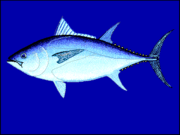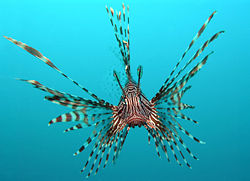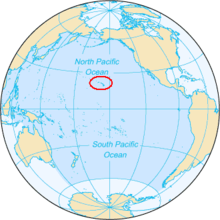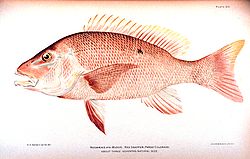Category Archives: Fish
Buzz Continues to Build Surrounding Theory That Volcano Cause Boom in Salmon Population
There has been a lot of buzz surrounding the speculation, which was tossed around this week, that a volcanic eruption on an Alaskan island back in 2008 is somehow responsible for the boom in the salmon population this year in the rivers of British Columbia in Canada.
If this speculation proves to be correct, it will help biologist’s to shed some new light on the rather unpredictable sizes of the populations of salmon year in and year out. It will also lend credence to the controversial idea of seeding the oceans of the world with iron to help lend a helping hand to other fish species, who have seen a decline in their populations. However, some scientists, who were contacted by Nature, have cautioned that the theory is “far fetched”.
After the salmon population took a nose dive back in 2009, the sockeye salmon made a big comeback in British Columbia’s Fraser River this year. It has been suggested that the reasoning behind this is that the iron in the ash from the volcanic eruption on Kasatochi island, which created a rather huge influx of phytoplankton, may have indirectly provided the salmon with the food they needed to stage a miraculous comeback. This suggestion was made by Tim Parsons, a prominent Canadian scientist, and has a government-awarded medal named after him for ocean scientists.
It looks like he may be getting yet another feather in his hat, if the scientific community chooses to explore this theory further. If its possible to refurnish fish stocks around the globe by seeding the ocean with some iron, we should take the opportunity.
Case Study: BP Oil Spill Take Toll on Bluefin Tuna, Satellites Don’t Lie!

The amazing Atlantic bluefin tuna, some of the largest of this species of fish can be as large as a Volkswagon Beetle, make their way to the Gulf every year from January until June. The peak time when they spawn is about mid April to May – just as BP was giving out free samples of its precious oil, when the well they had exploded and started pumping thousands of gallons of crude into the area this past April 20th.
This fish, which is paramount to commercial markets everywhere, mate in the surface waters, the females lay their eggs and the males fertilize away behind them. The oil present could cause harm to the eggs, larva and even the adults in the area. To make matters worse, the Atlantic tuna populations of the world have seen a drastic decline of 82% over the past three decades, so it is extremely important that they be allowed to mate without interruption.
Well, great job BP.. You really did cause quite the disturbances… How would they like it if we dumped oil into their beds as they were getting in the mood?
New Kind Of Fish Discovered
A brand new kind of fish has just been found in one of the dark “lifeless” areas of the ocean. It was previously thought that the area was devoid of fish, researchers say.
This new kind of snailfish was discovered making its home at an amazing depth of 7 kilometers, in the Peru-Chile trench in the South East Pacific.
Large groups of cusk-eels and rather large scavengers were also found making themselves at home at these depths, which is a scientific first, researchers added.
The discoveries, in some of the deepest darkest recesses of our planet, were made by a group of marine biologists hailing from the University of Aberdeen, in conjunction with experts from Japan and New Zealand.
The team set out on a 21 day voyage, during which they made use of various deep-sea imaging equipment to snap photos of the murky depths, some 4500 meters to an astounding 8 kilometers within the trench.
This voyage was the seventh such voyage as part of HADEEP, a research project cooked up by the boys over at the University of Aberdeen’s Ocean Lab and the University of Tokyo’s Ocean Research Institute, along with the backing of New Zealand’s National institute of Water and Atmospheric Research.
The use of the updated technology really gave researchers the boost they needed to discover this amazing find. Who knows what will be dredged up next? Science has been stale for such a long time, especially when you talk about the oceans, so it’s good to see some new discoveries being made right under our noses.
¨Hunters Becoming the Hunted: Lionfish Role Reversal!
The Ministry of Agriculture and Fisheries in Jamaica is taking some drastic measures to help prevent the collapse of the marine fisheries. They are now promoting lionfish as being a tasty treat for any menu. This effort is to help control the explosive growth of the lionfish population.
Officials have said that the nation’s marine biodiversity, its food security and economic well-being are all at risk.
“The situation in Jamaica is urgent,” commented the national coordinator for the Jamaican component of a Caribbean-wide Invasive Alien Species Project at the National Environment and Planning Agency, Nelsa English.
“A lack of sufficient natural predators suggests that it (lionfish) could be a potentially significant threat to Jamaica’s biodiversity and the ecosystem in general,” she added.
The marine resources of Jamaica are stretched dangerously thin, its reefs are being exploited to the point of extinction, and the fishing practices being used are detrimental to the environment. Some people even go as far as to use explosives to bring up their fish! Those that don’t often use toxic chemicals and nets whose mesh is illegally small.
Researchers have agreed that many of the once majestic reefs have been decimated to becoming mere communities of coral, and no longer operate as complete ecosystems due to the lack of diversity that calls them home.
Well seems to me that lionfish are part of the problem, and Jamaica has the answer. They are following suit as other nations are frying them up, putting them in sandwiches or using them as a pizza topping.
Shetland Boasts Smallest Fish in Europe
The smallest fish in Europe, the Guillet’s goby, was recently discovered in the waters of Scotland for the very first time.
Curious divers happened to snap photos of the tiny bloke while they were conducting surveys of the aquatic life to be found around the Shetland Islands.
Before this, Guillet’s goby has onl been spotted in the waters of Britain three times, but it was never spotted in Scotland before now.
This discovery, which was published in the journal Marine Biodiversity Records, us the furthest north that the fish has been found, and has extended it’s known range by a good 140 miles.
The reason this discovery is so momentous is that the Shetland Islands are famous for their larger fish, tourists flock there to whale and dolphin watch.
However, Dr Richard Shucksmith and Rachel Hope, independent marine biologists were in the midst of making a documentary on the smaller species that make their home in the islands, when they stumbled upon this tiny specimen.
They snapped many pictures of the Guillet’s gobies, known in scientific circles as Lebetus guilleti, at Lunna Kirk during their different dives this past summer.
“It never crossed our minds that we would find such a rare fish or that it would be Europe’s smallest marine fish,” Dr Shucksmith explained.
“When Rachel spotted the goby she knew it was something different so made sure she got some pictures so we could identify it when we got home,” he continued.
“Whale Wars” Captain Captain Cover Ups, Lies: “Dishonest” and “Morally Bankrupt”
The Sea Shepherd Conservation Society (SSCS), which is known round the globe as the crew from Animal Planet’s “Whale Wars” has gone by many titles, pirates, environmentalists and even eco-terrorists. However, no matter what you may call them, they are now calling one of their own “dishonest” and “morally bankrupt”, and are going as far as to say that they have been involved in conspiracies and cover-ups.
The former captain of Sea Shepherd, Pete Bethune, who hails from New Zealand, has struck out against the motley, yet sometimes dangerous, group of people who consist of weekend warriors, college activists, and even professionals on vacation. They are well known for causing a ruckus for Japanese whalers, in an attempt to save the whales. However, he seems to be targeting Captain Paul Watson, and accuses him of pulling the wool over the public’s eyes on more than one occasion, exaggerate facts and exploits, among other things.
He even went so far as to write an in depth expose on his Facebook page, and then made himself available for a lengthy piece on the site ecorazzi.com. Bethune even goes as far to offer an “online letter of resignation.”
“I am asking that from now on, SSCS determine to act in an honest way with its volunteers, supporters and media,” Bethune writes as a comment on Facebook. “SSCS does not need to lie. Saving whales, dolphins, tuna and sharks are noble causes, and the public will embrace these as worthwhile. The story does not need to be manipulated and changed in order to get public support.”
While this is certainly an interesting turn of events, only time will tell what, if anything, will come of these accusations.
Oceans Are Becoming Overcrowded, Salmon In Danger, B.C Scientists Fear Worst
The wild salmon of the North Pacific are becoming fewer in number as they are being forced to fight for their food and rapidly declining living space, as billions of farmed salmon are being released into the oceans every year, a study by researchers out of B.C. and Washington State explains.
The concern is coming from the fact that the salmon populations, mainly of the sockeye, pink and chum variety, across the Pacific Rim is much higher than usual.
“The total number of salmon out there is at an all-time high, in fact, the abundance is about double what it was in the 1950s,” commented a fisheries management scientist at Simon Fraser University, Randall Peterman, who is also a co-author of the newly published report.
Releasing a huge amount of artificially grown salmon to help and supply a food fishery is detrimental to the native salmon, he explains. “Hatchery fish have been causing deterioration in the wild population for some time.”
“The fact is that hatchery fish from one nation can influence the health of salmon stocks in another nation,” Peterman explains. The amount that these hatcheries release, especially in Alaska and Japan, has reached a level of an astounding five billion salmon a year and it’s continuing to increase. Which means that the salmon are under imminent threat.
First it’s overfishing, now it’s over fish releasing? Well I have an answer for you boys, grab the frying pan, it’s time for a fish fry…
Thieves Sneak Off With Catch From Aquarium in Waikiki
Thieves made off with 15 moi (a type of featherfin) from a display tank situated at the Waikiki Aquarium this past weekend.
They forced their way into the aquarium after it had shut its doors for the day, and made off with 15 of the 21 fish in an outdoor tank, sometime between Friday evening and Saturday morning, officials at the aquarium stated.
They made their way over a chain-link fence, cut out an opening in the netting of the tank, and then proceeded to abduct the fish using their own net, officials at the Waikiki Aquarium reported.
“It looks like they threw the moi out, they lay on the ground there and they put them in the bag,” Director of the Waikiki Aquarium, Andrew Rossiter, explained. “There were scales and blood there. There were two dead moi left there in the morning that they missed.”
Workers at the aquarium found the two deceased moi left unceremoniously on the ground in front of the tank.
The estimated value of the stolen fish is around $1,500, though who knows what someone will pay for them on the black market.
Even though the fish were stolen, Rossiter feels the need to implore that these particular fish are not fit for human consumption, as they were prepped for breeding and thus contain some hormones and chemicals which make a fairly unappetizing cocktail.
“I would guess that they’ve been treated probably with hormones and probably with medication because they’re adult fish and they were for breeding,” he said.
One wonders why not take all the fish? And also.. What the heck are they going to do with them?
Despite Oil Spill, Fish Fry Showing up In Record Numbers in Gulf of Mexico
Snapper fry are all over the place. There are also trout, grunt and grouper fry all over the place as well. The early tabulation of the annual count in the beds of grass spattered about the northern part of the Gulf of Mexico seems to suggest that the larvae of some kinds of fish have survived the BP oil fiasco, and what’s more, there are swarms of them.
“My preliminary assessment, it looks good, it looks like we dodged a bullet. In terms of the numbers of baby snapper and other species present in the grass beds, things look right,” commented a scientist with the University of North Carolina’s Institute of Marine Science, Joel Fodrie, who has been actively involved in the study of seagrass meadows along the coast for the past five years.
Joel’s group has taken samples of the different sea life in the grass beds in Alabama, Mississippi, and the Florida Panhandle. They will be taking a sample from around Louisiana’s Chandeleur Islands come this Autumn.
Back at the height of the fiasco, when a seemingly endless stream of oil was floating about on the surface, researchers were most concerned as to whether the trillions of larvae which hatch each spring offshore would survive the severe contamination of the spill.
It’s looking like they did, and it’s a good thing too. It just goes to show you that mother nature is more resilient than we give her credit for. There is hope yet for the Gulf to make a full recovery, and that folks, is good news indeed.
Metro Markets to Stop the Sale of Fish Which are Endangered:
The famous operator of supermarkets, Metro Inc., has united with other big name food, retailers such as Loblaws and Walmart, to help adopt a sustainable fisheries policy, whereby it will stop selling those species of fish which are deemed to be at risk, or endangered.
“Starting today, Metro will temporarily withdraw seven threatened species,” the Quebec-based chain commented in a statement released this past Thursday.
The different kinds of fish set to be removed from the shelves include: Atlantic cod, bluefin tuna, orange roughy, Chilean seabass, New Zealand hoki, skate and shark.
“These species will be substituted with other products and might be reintroduced in the future if scientific reports indicate that their stocks have climbed back up to acceptable levels,” Metro explained.
Metro is instituting this new policy slowly, so as to not completely shock their consumers. They expect to have the policy in full swing in stores across Ontario and Quebec by the end of June 2011.
This policy means that Metro will only be offering fresh and frozen, wild and farmed seafood products which are not on the endangered list, and come from fisheries which are sustainable. It also means that all their suppliers will need to sign a code of conduct, and agree to abide by the new policy when selling products for resale.
“To facilitate the traceability of its seafood products, Metro has developed a new, more transparent labelling system to help consumers make informed choices,” it added.
It’s nice to see big businesses willing to put a bit of pressure on the fisheries to look after the health of our worlds’ oceans. Hopefully this will spur other large organizations to do the same, and the sea will be a happier place.






